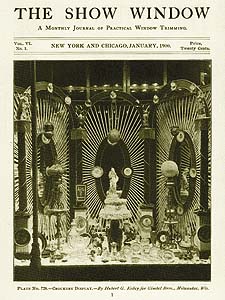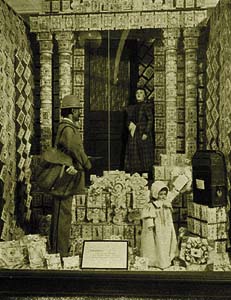With December 2000 easing into January 2001, we're welcoming the true beginning of the new Millennium – with little fanfare but much reflection. During the past 100 years, retail has been the stage for the latest fashions and the newest technologies. It has evolved with society.
In the coming months, VM+SD will review a century of visual merchandising and store design excellence. How have the events of the day affected our stores? Can contemporary trendsetters find inspiration from past visionaries? How will revisiting a glorious past guide us into an unbounded future? In this spirit, we offer a century of retail design: a celebration of our great industry!
As the showplace for new concepts and fashions, retail is the litmus for a changing market and a changing world. If we hold a mirror up to the face of society, the reflected image would be commercialism, spawning great movements in art, architecture, design and technology. Historian Pierre Daix noted in the October 1996 issue of Art News: “The history of art is not just in sculpture. There is a whole cultural history behind it. You can't understand Cézanne without Stendhal, Manet without Baudelaire. In the period of modern art, the writers, painters and the political revolution all came together.”
Today, we are crossing the threshold of a global community, facing great political change, fascinating new technologies and difficult economic challenges. Moving forward, we look to the past with an eye on the future. We recall a period when varying forms of cultural expression “came together.” It would be difficult to understand the past century of retail design without understanding a century of cultural development. Cultural movement drives retail innovation. Great art, architecture, literature and painting all blend and co-exist. All are reflective of their times and all have made an impact on retail design.
Immigrants and dry-goods shops
Advertisement
The grand institution that is the department store began with the small dry-goods shops of lower Manhattan in the early 1820s. As immigration surged ahead, so, too, did commerce and industry. These small establishments soon became empires for the wants, desires and appetites of the growing populace.
Walk through the area that was New York's Ladies Mile. The heart of retail in the Manhattan of the early 1900s – a section bounded by 23rd Street and 8th Street, between Broadway and Sixth Avenue – it reveals a more opulent time. Gaslight lamps, cobblestones and cast-iron architecture were the order of the day. Stylish patrons flocked to these great stores, yearning for the latest fashions, from shirtwaists to wing collars and the finest of fabrics.
When it opened in 1896, the Siegel-Cooper & Company building was the largest department store in New York (now the home of Bed, Bath & Beyond), dominating the Sixth Avenue landscape at 18th and 19th streets. The same great bronze columns and lanterns of its majestic facade that beckoned the shoppers of yesterday delight the historians of today.
The main attraction of the store was its glorious fountain, a colossal white-marble and brass statue of The Republic framed by a circular marble terrace. Sprays of streaming water, illuminated by multi-colored lights, danced around the statue's granite base. Customers leaned over a mahogany balustrade that accented the well on the second floor to view this grand spectacle. The fountain became a prominent meeting spot for shoppers, businessmen and tourists alike. Even lovers were known to meet at the fountain. The phrase “Meet me at the fountain” became part of New York's lexicon.
The impressive roster of renowned stores included The John Wanamaker Store (designed by Daniel H. Burnham, architect of the Flat Iron Building), James A. Hearn & Son, B. Altman, Hugh O'Neill (with its wonderful Corinthian columns), Best & Company (the well-known children's store), the Lord & Taylor structure (with its mansard roof and cast-iron dormers on the corner facade), the esteemed Arnold Constable, the Beaux-arts style Adams Dry Goods Store and the James McCutchean Store.
The original Stern Brothers Store on 23rd Street, between Fifth and Sixth avenues, is still in mint condition today, a great example of cast-iron architecture, which – coupled with the availability of plate glass – was a keystone to merchandising theater. These building technologies led to the development of large show windows with the ability to span large spaces. And these innovations were the sparks that led to the inception of the visual merchandising and store design industries.
Advertisement
Photos courtesy of ST Publications, Cincinnati


 Headlines1 week ago
Headlines1 week ago
 Photo Gallery1 day ago
Photo Gallery1 day ago
 Headlines2 weeks ago
Headlines2 weeks ago
 Headlines2 weeks ago
Headlines2 weeks ago
 Sector Spotlight1 week ago
Sector Spotlight1 week ago
 Headlines1 week ago
Headlines1 week ago
 Headlines1 week ago
Headlines1 week ago
 Headlines3 days ago
Headlines3 days ago















